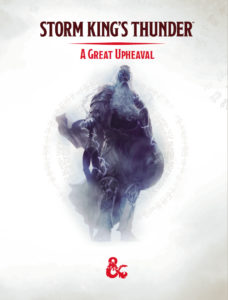

“Try Before You Buy” is an occasional segment of Astral Projections. It spotlights free (or nearly free) supplements, quick-start rules, and modules for various RPGs.
“A Great Upheaval” is the free 22 page introductory module for Storm King’s Thunder, the latest D&D 5e adventure supplement. (Suggested retail price of US$49.95) It is intended to take a Level 1 party to Level 5. The campaign can be used for Adventurer’s League play, and like all League campaigns, is set in the Forgotten Realms world. It can be downloaded from DriveThruRPG. The download includes Player’s and GM’s Guides and Side Quests, all for Adventurer’s League play, if you are interested in that. Note for potential players–this is a spoiler-free as I can make it.
This intro adventure is the first chapter of Storm King’s Thunder, and is set in and around a small settlement, where the party arrives in the aftermath of an attack. The portion in Nightstone appears fairly self-contained, but does lead into what I am presuming is the next part of the arc, with the PCs en route to one of three possible destinations. Unfortunately, reading the module, I didn’t feel much drive at the end to go ahead and find out what happens upon arrival at the destination. It wasn’t a cliffhangar ending. After the second of two possible on-the-road encounters, it just–ended. I am sure this is because it is an excerpt from a full sourcebook and reads differently there, where a GM can see how it ties in, beyond the obvious–Giants!
The adventure itself was well-written. I liked how the encounters were set up, including minimalist railroading within given encounters. In one for example, they meet a group coming to assist an NPC and the GM information doesn’t assume the PCs and NPC Party will be either friends or foes. The same with rescuing several locals from a tribe of low-level monsters. The PCs clearly have options to fight/kill them all, sneak, strike a deal with Monster A, or bargain with/intimidate/kill the chieftain. There is still railroading to keep the party going in the direction of the next campaign arc. When a friendly NPC offers transport, if they request a place other than one of the three quest sites, he “gets a little befuddled and ends up taking them to one of these places by accident.” Humorous, but still serious railroading.
The NPCs are all well-developed, even minor ones. All the local families have names, including members killed in the disaster that befell the town hours before, and with some information about them. Lots of diversity for such a small village, too–halflings, a Tiefling mother and son, even a gay couple. The monster tribe members all have names, even the ones intended for the players to catch looting various buildings. I thought it was a nice touch. And the one giant the party encounters is refreshingly non-stereotyped. Different profession, different attitude, different role/s in the scenario. Good job!
Locations are well done, too. The motte-and-bailey style of the settlement is described accurately–I checked it out online and with my military-history-buff husband. The maps are clear, complete, and well-drawn. I didn’t recognize the cartographers’ names but the quality of Wizards’ maps hasn’t gone down. I quickly grew tired, however, that practically every house, hidey-hole, or cave in the scenario ended with a treasure list, right down to silver and copper pieces. However, it might be just the standard format–it has been a version or two since I read a D&D module.
I have no idea what the entire plot of the campaign is, other than the blurb on the WotC page (first link above). I deliberately didn’t look for any, because if I play Storm King’s Thunder, it will be as a player, not a GM. But it looks like it would be a fun scenario, even if simply adapted for your own campaign. A group can also play it to see if the full campaign book would be fifty dollars’ worth of fun for them.
Linda Whitson
Latest posts by Linda Whitson (see all)
- Astral Projections – The Ripperdoc Is In - May 8, 2023

I, too, get tired of the inevitable treasure lists.
They’re largely pointless — coppers don’t matter by the time you hit 3rd level (and silvers hardly do) unless there’s a vast number of them and the question is how to move the sheer mass of metal involved — and the encourage a ‘loot all the things’ style of gameplay that drives me a little nuts. The occasional hidden treasure is great, but stopping to search every belt-pouch, hovel, and casket gets really old, really fast.
I much prefer to just give the players a large, obvious treasure hoard as the reward for completing a mission objective or getting to a certain point, and other than that I’ll usually call out anything of value (old books, objets d’art, etc) and any looting besides that I handwave with ‘he has a few coins’ or ‘nothing of outstanding value’.
Though all that said, my experience with 5e has been that there’s just not that much point to gathering gold. Unless you put together a castle with a treasury and actually track kingdom expenses, the only way you’re going to spend thousands of gold are on buying magic items (which is somewhat deprecated by the DMG) or paying gold to work on making them yourself (which is more reasonable but pretty rare in most games).